This article needs additional citations for verification .(January 2019) |
The Italian Julian Alps are a mountain range that is part of the Italian Alps that extends from Italy to Slovenia.
Contents

This article needs additional citations for verification .(January 2019) |
The Italian Julian Alps are a mountain range that is part of the Italian Alps that extends from Italy to Slovenia.

The Julian Alps begin on the southern side of Sella Carnizza in the Resia Valley and extend to Fella, Dolina and Bohinjka rivers. [1] The Predil Pass divides the east and west sides of the Julians.
The Julian Alps contain the current border between Italy and Slovenia. Throughout the history of the region, national borders have changed several times around the Julians.
Prior to World War I the border between Italy and Austria ran from Mount Matajur to Mount Kanin, then along the ridge towards Cima Confine and down east from Sella Nevea past the Rio del Lago valley, then along the main crest of Mount Cregnedùl up to the top of the Montasio, down the Somdogna Saddle to finally reach Pontebba. Between the two World Wars, the Eastern Julian Alps were under the dominion of Italy and so was the most part of the Western ones: the political border ran along the Ponze range from the Ratece Saddle to Mount Jalovec, along Site and Mojstrovske mountains upwards to Mount Prisojnik, to Mounts Kriz and Luknja and finally the Tricorno; the whole valley of the Isonzo river was in the Italian territory.
Julius Kugy is a poet and mountaineer who is renowned for opening up routes in the Julian Alps, climbing previously unclimbed peaks as well as his poetry about the region.
The fauna of the Julian Alps is very rich as well, a heritage that has to be protected and controlled by the hunting and fishing regulation made by dedicated authorities in the best possible way. More than one thousand species of insects live in the valleys and on the slopes, in the woods you can meet foxes, hares, roes [2] and other minor rodents and mammals, nearby specimens of tetraonides like grouses and cocks of the wood. High pastures are the domain of chamoises, ibexes, reintegrated from 1970, white partridges. In between the rocks nest the woodpecker, the raven with the yellow bill, last but not least the eagle, strictly protected. Among the reptiles there are the horned viper (Vipera ammodytes) and the Vipera berus, easy to be found over the Montasio plateau, on the southern side of Mount Cimone, towards the Mount Nebria; other reptiles are the black salamander and the alpine triton, with its characteristic red stomach.
The names of places in the Italian Julian Alps have been influenced by people living together for centuries, with words coming from Latin, German and Slavic, mixed up with the local dialects (German from Karinthia, Slav and “Furlàn”). The final influence comes from the Italian dominion, beginning after the Second World War.
There are many different ways of access to the Julians:
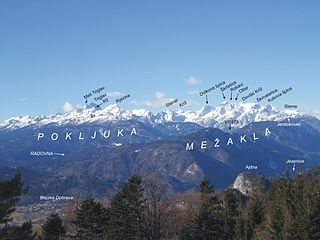
The Julian Alps are a mountain range of the Southern Limestone Alps that stretch from northeastern Italy to Slovenia, where they rise to 2,864 m at Mount Triglav, the highest peak in Slovenia. A large part of the Julian Alps is included in Triglav National Park. The second highest peak of the range, the 2,755 m high Jôf di Montasio, lies in Italy.

Tarvisio is a comune (municipality) in the Regional decentralization entity of Udine, in the autonomous Friuli Venezia Giulia region of Italy.

Bovec is a town in the Littoral region in northwestern Slovenia, close to the border with Italy. It is the central settlement of the Municipality of Bovec.

Sella Nevea, at an altitude of 1,195 m (3,921 ft), is a high mountain pass in the Julian Alps, in the Friuli-Venezia Giulia region of northeast Italy. Sella Nevea also lends its name to a frazione of the Chiusaforte municipality and the nearby Kanin-Sella Nevea Ski Resort.

Chiusaforte is a comune (municipality) in the Regional decentralization entity of Udine in the Italian region of Friuli-Venezia Giulia.

Malborghetto Valbruna is a comune (municipality) in the Regional decentralization entity of Udine in Friuli-Venezia Giulia, north-east Italy.

Moggio Udinese is a comune (municipality) in the Regional decentralization entity of Udine in the Italian region Friuli-Venezia Giulia.
Resia is a comune (municipality) in the Regional decentralization entity of Udine, in the Friuli-Venezia Giulia region of northeast Italy, bordering on the municipalities of Chiusaforte, Lusevera, Resiutta, and Venzone, and also on two of the Slovenian municipalities. Its residents speak an archaic dialect known as Resian, which is – according to most linguists – a transitional dialect between the Carinthian and Littoral dialects of Slovene. Although they maintain their own traditional system of family names, which are of Slavic origin, the people of Resia have either Italian or Italianized surnames, similarly to some areas in Venetian Slovenia.
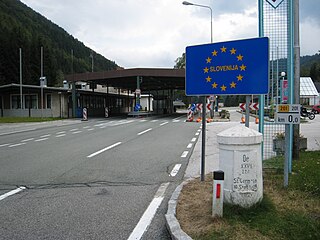
The Wurzen Pass is a mountain pass in a col of the Karawanks mountain range in the Southern Limestone Alps, on the border between Radendorf in the Austrian state of Carinthia and Kranjska Gora in Slovenia. It is named after the nearby village of Podkoren (Wurzen).

The Predil Pass or Predel Pass is a high mountain pass on the border between Italy and Slovenia.

The Alpine Brigade "Julia" is a light infantry brigade of the Italian Army, specializing in mountain warfare. Its core units are Alpini, an infantry corps of the Italian Army, that distinguished itself during World War I and World War II. The brigade carries on the name and traditions of the 3rd Alpine Division "Julia". The division's and brigade's name allude to the Julian Alps in the Friuli region where the division's regiments recruited their troops, and where after World War II the brigade was based. Accordingly, the brigade's coat of arms is modeled after the Friuli region's coat of arms.
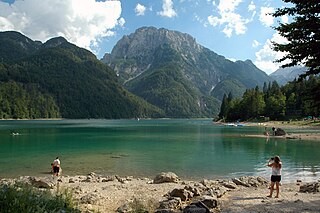
Lake Predil is a lake near Cave del Predil, part of the Tarvisio municipality in the Province of Udine, in the Italian region of Friuli-Venezia Giulia.

Cave del Predil is a frazione subdivision of the comune of Tarvisio in the Province of Udine, in the Friuli-Venezia Giulia region of northeastern Italy.

The Kanin Mountains or the Canin Mountains, mostly simply Kanin or Canin, are a mountain range in the Western Julian Alps, on the border of Slovenia and Italy. Their highest summit, High Kanin is 2,587 m above sea level. They separate the upper Soča Valley in Slovenia from the Resia Valley in Italy.

The Slizza (Italian) or Gailitz is an Alpine torrent in Italy and Austria, a right tributary of the river Gail. Its drainage basin is 212.5 km2 (82.0 sq mi).

The Jôf di Montasio is located in the Province of Udine, in the Friuli-Venezia Giulia region of northeastern Italy.
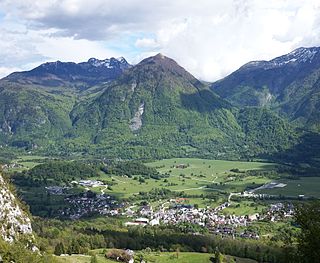
The Municipality of Bovec is a municipality in northwestern Slovenia. Its center is the town of Bovec. As of June 2016, its mayor is Valter Mlekuž.
Slovene minority in Italy, also known as Slovenes in Italy is the name given to Italian citizens who belong to the autochthonous Slovene ethnic and linguistic minority living in the Italian autonomous region of Friuli – Venezia Giulia. The vast majority of members of the Slovene ethnic minority live in the Provinces of Trieste, Gorizia, and Udine. Estimates of their number vary significantly; the official figures show 52,194 Slovenian speakers in Friuli-Venezia Giulia, as per the 1971 census, but Slovenian estimates speak of 83,000 to 100,000 people.

Mount Prestreljenik is a 2,499-meter (8,199 ft) mountain in the western range of the Julian Alps, in the Tolmin region of Slovenia on the Italian–Slovenian border. It is the second-highest peak in the central part of the Kanin group. Prestreljenik is known for the Window (Okno), an erosion-arch feature located on its western ridge. This aperture is the source of both of the mountain's local endonyms; Prestreljenik means 'shot-through' in Slovene, and Forato is Italian for 'pierced'
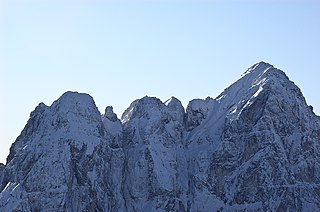
Jôf Fuart is a mountain of the Julian Alps in Friuli-Venezia Giulia, Italy.